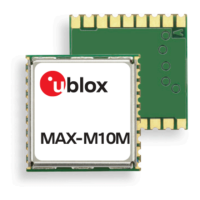MAX-M10M-Integration manual
the receiver to use GPS and GLONASS satellite signals to generate BeiDou time. This practice
compromises time pulse accuracy if the receiver cannot measure the timing difference between
the constellations directly and is therefore not recommended.
The information that allows GNSS times to be converted to the associated UTC times is
only transmitted by the GNSS at relatively infrequent periods. For example GPS transmits
UTC(USNO) information only once every 12.5 minutes. Therefore, if a time pulse is configured to
use a variant of UTC time, after a cold start, substantial delays before the receiver has sufficient
information to start outputting the time pulse can be expected.
Each GNSS has its own time reference for which detailed and reliable information is provided in the
messages listed in the table below.
Time reference Message
GPS time UBX-NAV-TIMEGPS
BeiDou time UBX-NAV-TIMEBDS
GLONASS time UBX-NAV-TIMEGLO
Galileo time UBX-NAV-TIMEGAL
QZSS time UBX-NAV-TIMEQZSS
UTC time UBX-NAV-TIMEUTC
Table 23: GNSS time messages
3.7.3 Navigation epochs
Each navigation solution is triggered by the tick of the 1 kHz clock nearest to the desired navigation
solution time. This tick is referred to as a navigation epoch. If the navigation solution attempt is
successful, one of the results is an accurate measurement of time in the time base of the chosen
GNSS system, called GNSS system time. The difference between the calculated GNSS system time
and receiver local time is called the clock bias (and the clock drift is the rate at which this bias is
changing).
In practice the receiver's local oscillator is not as stable as the atomic clocks to which GNSS systems
are referenced and consequently clock bias tends to accumulate. However, when selecting the next
navigation epoch, the receiver always tries to use the 1 kHz clock tick which it estimates to be closest
to the desired fix period as measured in GNSS system time. Consequently, the number of 1 kHz clock
ticks between fixes occasionally varies. This means that when producing one fix per second, there
are normally 1000 clock ticks between fixes, but sometimes, to correct drift away from the GNSS
system time, there are 999 or 1001 ticks.
The GNSS system time calculated in the navigation solution is always converted to a time in both
the GPS and UTC time bases for output.
Clearly when the receiver has chosen to use the GPS time base for its GNSS system time, conversion
to GPS time requires no work at all, but conversion to UTC requires knowledge of the number of
leap seconds since GPS time started (and other minor correction terms). The relevant GPS-to-UTC
conversion parameters are transmitted periodically (every 12.5 minutes) by GPS satellites, but can
also be supplied to the receiver via the UBX-MGA-GPS-UTC aiding message. By contrast, when the
receiver has chosen to use the GLONASS time base as its GNSS system time, conversion to GPS
time is more difficult as it requires knowledge of the difference between the two time bases, but as
GLONASS time is closely linked to UTC, conversion to UTC is easier.
When insufficient information is available for the receiver to perform any of these time base
conversions precisely, predefined default offsets are used. Consequently, plausible times are nearly
always generated, but they may be wrong by a few seconds (especially shortly after receiver start).
UBX-22038241 - R02
3 Receiver functionality Page 44 of 92
C1-Public

